Discover the best things to do this Winter in Bruce Peninsula! From snowshoeing at Bruce Peninsula National Park to exploring frozen caves and scenic trails, here are 5 must-do winter activities in Bruce Peninsula.
Bruce Peninsula isn’t just a summer hotspot—it’s a breathtaking destination all year round. When winter arrives, the landscape transforms into a stunning wonderland of snow-covered forests, frozen shorelines, and crisp, refreshing air. The region becomes quieter, offering a peaceful retreat for those looking to experience nature without the summer crowds.
Outdoor enthusiasts will love the variety of activities available, from snowshoeing through scenic trails to exploring ice-covered caves and witnessing frozen waterfalls. The beauty of Bruce Peninsula in winter is unmatched, making it an ideal spot for adventurers, photographers, and anyone looking for a unique Ontario getaway. Bundle up, grab your camera, and get ready to explore these five must-do activities this Winter in Bruce Peninsula.
Read More // Visit the Ontario section of my blog to find more inspiration for your next visit in my beautiful province!
Here’s why you should consider Winter in Bruce Peninsula!
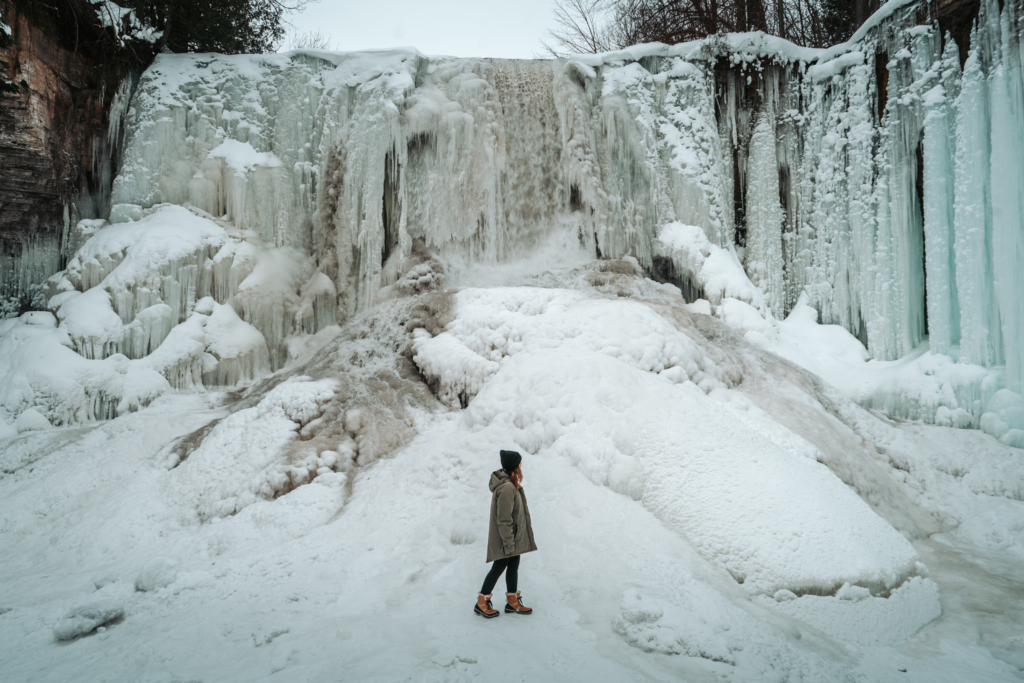
5 Must-Do Activities this Winter in Bruce Peninsula
Go Snowshoeing in Bruce Peninsula National Park
One of the best ways to explore Bruce Peninsula in winter is by snowshoeing through its scenic trails. Bruce Peninsula National Park offers several routes that take you through snow-covered forests and stunning frozen lakes. The Horse Lake Trail and Georgian Bay Trail are popular choices for a peaceful winter hike.
Recommended Trails:
- Georgian Bay Trail (3 km round trip) – A moderate hike leading to stunning views of Georgian Bay.
- Horse Lake Trail (2.5 km round trip) – A scenic, shorter trail that offers peaceful lake views.
- Halfway Log Dump Trail (4 km round trip) – A more challenging option with impressive winter scenery.
Hiking Tip // Although some trails are fine to do without snowshoes, they are highly recommended for deeper snow on trails like the Georgian Bay Trail.
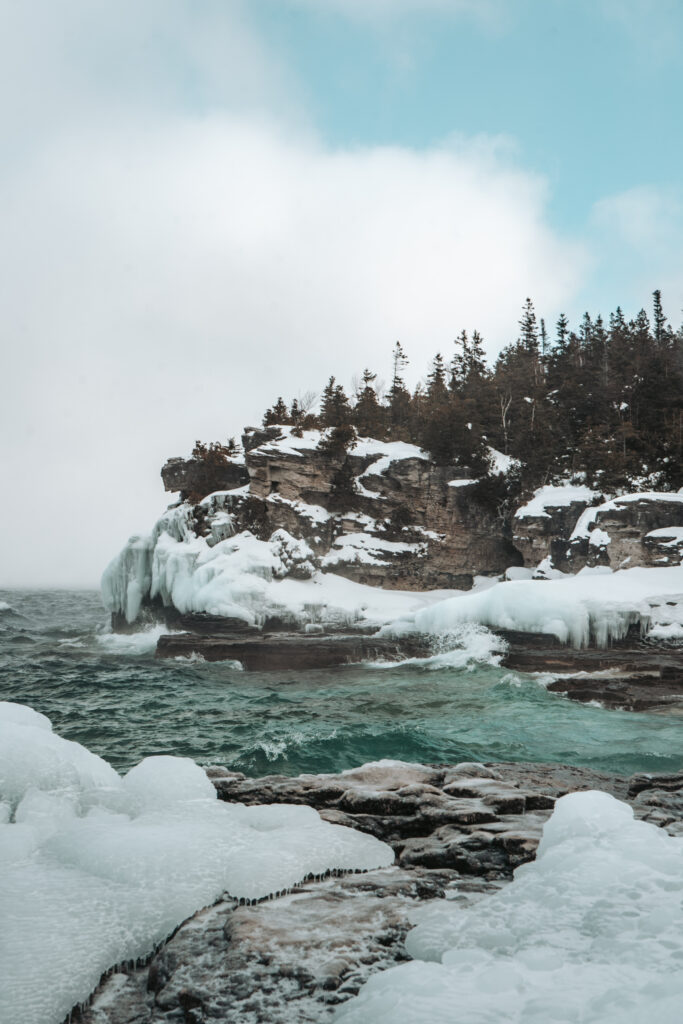
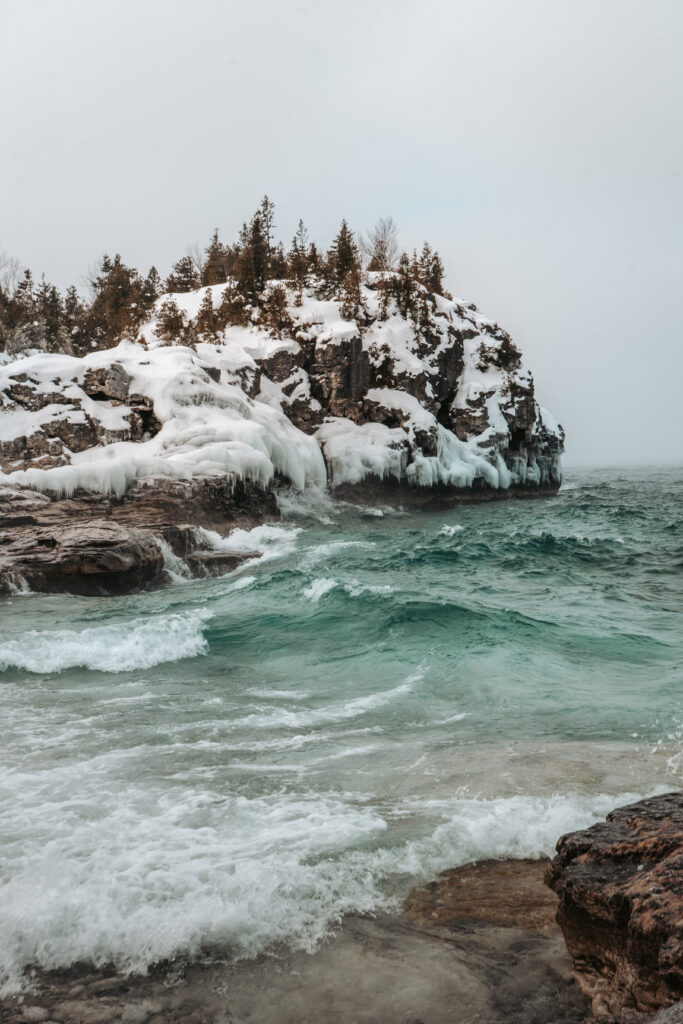
Visit the Frozen Grotto at Indian Head Cove
While you are at Bruce Peninsula National Park, make sure to visit the Frozen Grotto at Indian Head Cove. Indian Head Cove is famous for its turquoise waters in summer, but in winter, it becomes a frozen wonderland. The Grotto, a sea cave carved by the waves, takes on a magical appearance when surrounded by ice formations and snow-covered cliffs. The contrast between the white snow and deep blue ice creates an almost otherworldly effect, making it one of the most photographed spots in Bruce Peninsula during winter. The sight of frozen icicles hanging from the cave walls makes for an unforgettable experience.
Hiking Tip // The hike to the Grotto is approximately 1 km each way from the parking lot and can be challenging in winter. Wear ice cleats for better traction when hiking, as the trails can be slippery. Dress in warm, layered clothing to stay comfortable, and bring a flashlight if visiting later in the day as winter daylight hours are shorter.
How much does it cost to visit the Grotto?
The Grotto is part of Bruce Peninsula National Park, so an entrance fee is required. Check the Parks Canada website for the most up-to-date information before your visit.
- Adults (18-64 years): $9.00
- Seniors (65+ years): $7.75
- Youth (6-17 years): Free
- Family/Group (up to seven people in a single vehicle): $17.50
For specific attractions within the park, such as The Grotto, there is an extra parking fee of $15.75 per vehicle. No reservation is necessary in the Winter!
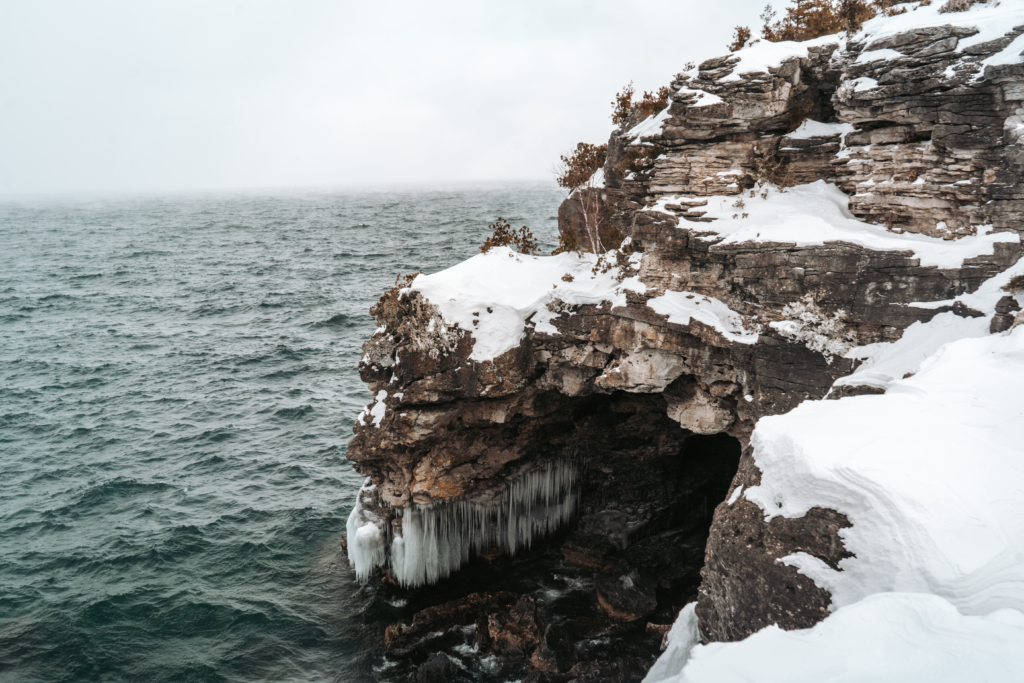
Explore the Ice Formations at Singing Sands Beach
I didn’t get the chance to visit Singing Sands Beach during my trip, but I’ve heard incredible things about it. Seeing the frozen formations in person is now at the top of my list for my next winter adventure in Bruce Peninsula.
Singing Sands Beach, located on the western side of Bruce Peninsula, offers a unique winter experience. As temperatures drop, the shallow waters freeze over, creating bizarre ice formations that look like natural sculptures. The combination of wind, waves, and freezing temperatures shapes the ice into intricate patterns and formations, making it a surreal and ever-changing landscape.
Unlike the rugged cliffs of the Grotto, Singing Sands Beach provides a wide-open expanse where you can walk along the frozen shoreline and observe how the ice interacts with the sand. The stark contrast between the white snow, ice formations, and the golden sand beneath makes it a dream location for winter photography.
This is supposedly one of the best spots for winter photography, capturing the contrast between ice, sand, and snow. The unique formations vary each year, so no two visits will ever look the same.
Photography Tip// Visit at sunrise or sunset for dramatic lighting and a more serene experience. The low angle of the winter sun enhances the textures of the frozen beach, creating incredible photographic opportunities. Be sure to wear warm, waterproof boots as some icy patches can be slippery.
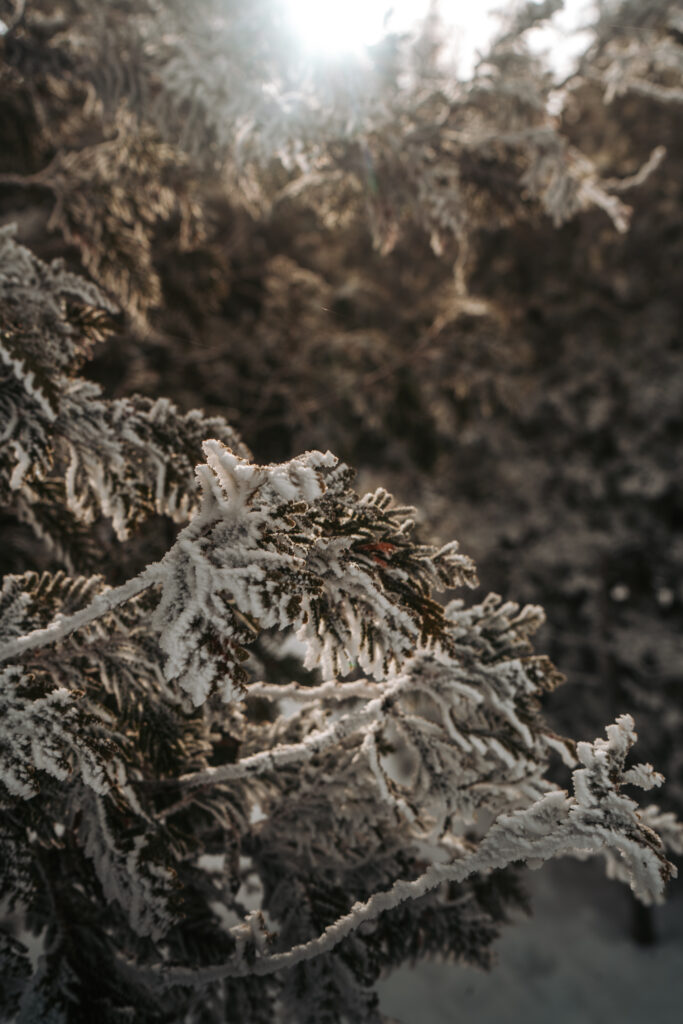
Explore Bruce Caves Conservation Area
This is another place I didn’t get to visit on my last visit but I definitely will next time I’m in Bruce Peninsula!
Bruce Caves Conservation Area is a hidden gem in the winter, offering a unique experience of exploring limestone caves that take on an entirely new look when covered in ice and snow. These caves were formed thousands of years ago by the waves of a glacial lake, leaving behind towering rock formations and deep recesses that are now part of this conservation area. In winter, the combination of ice, snow, and rugged rock makes it feel like stepping into a prehistoric frozen world.
The short 1.5 km round-trip hike to the caves takes you through a tranquil forest before reaching the impressive rock walls. Snowshoes are recommended when there’s heavy snowfall, as the trail can become deep with snow, making navigation more difficult.
Hiking Tip // The caves can be very slippery in winter, so ice cleats or traction aids are highly recommended. If you’re a photographer, visit in the morning for the best natural lighting filtering into the caves.
The Details
Where | Find Bruce Caves Conservation Area on Google Map here.
Price | Although the entrance to the Conservation Area is free, you will have to pay a 10$ parking fee.
Visit Frozen Waterfalls in Owen Sound
While not technically in Bruce Peninsula, Owen Sound’s frozen waterfalls are just a short drive away and well worth the visit. This area is known as the Waterfall Capital of Ontario, and during the winter months, these waterfalls transform into breathtaking ice formations, creating a stunning frozen landscape. Here are some of the top waterfalls to explore:
Inglis Falls – It was covered in snow during my visit so I wasn’t able to see it’s majestic beauty… But it’s one of the most famous waterfalls in the region, Inglis Falls cascades over an 18-meter-high rock face. In winter, the flowing water freezes into intricate ice formations, making it a picturesque and must-see stop.
- Accessibility: Easy access with a short walk from the parking area.
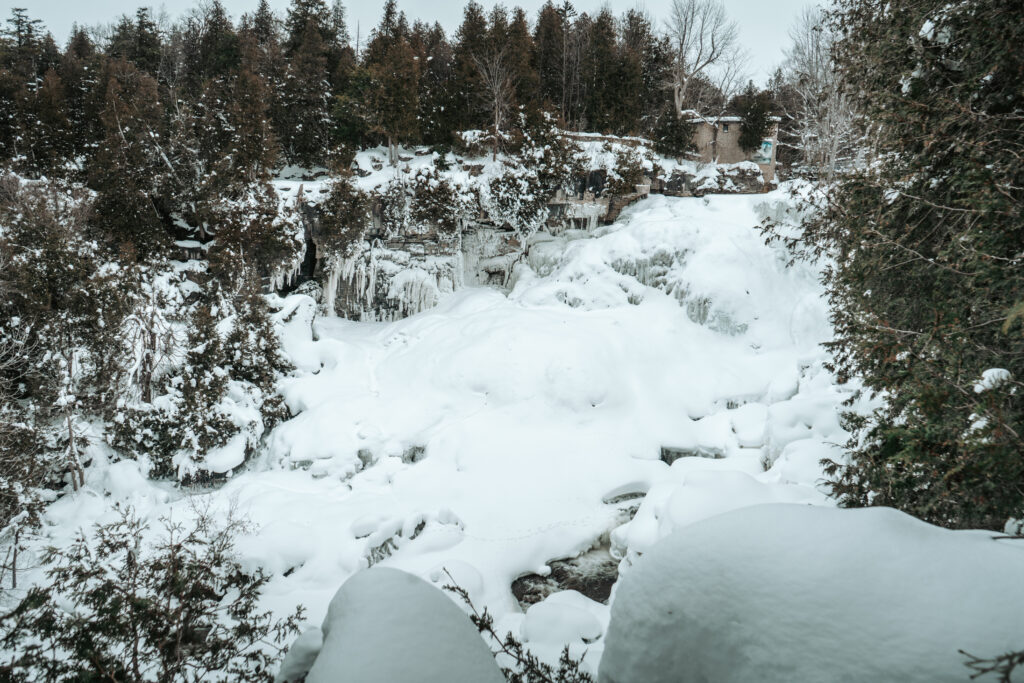
Indian Falls – A more adventurous winter stop, Indian Falls is a 15-meter-high cascade waterfall that freezes into a solid curtain of ice. The trail to the falls is around 1.5 km one way, and snowshoes may be needed in deeper snow conditions.
- Accessibility: Moderate-level hike through forested terrain.
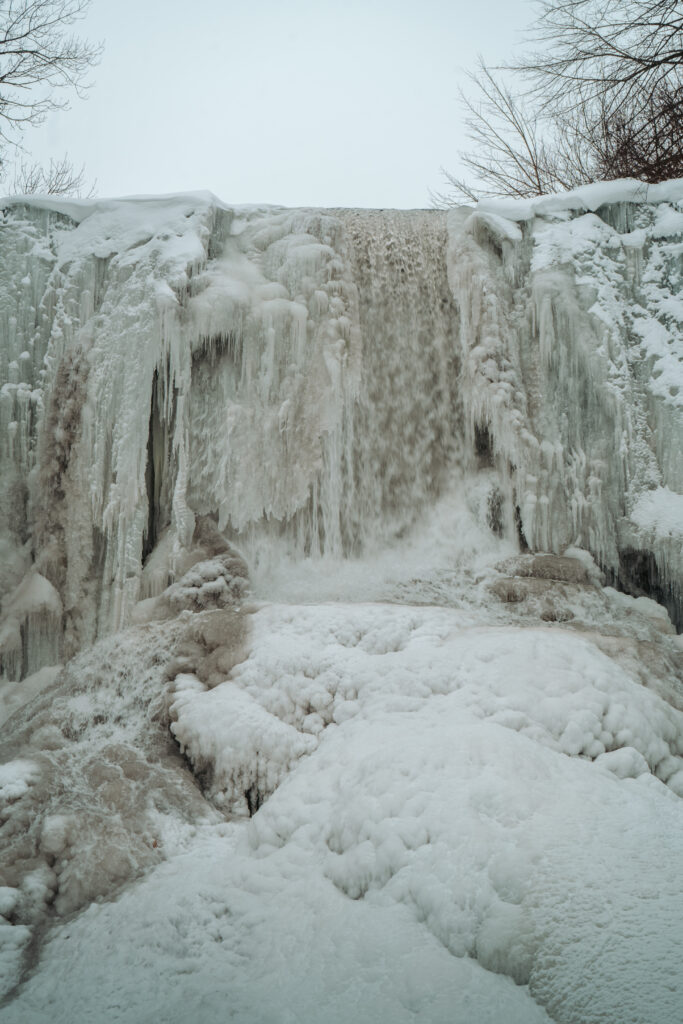
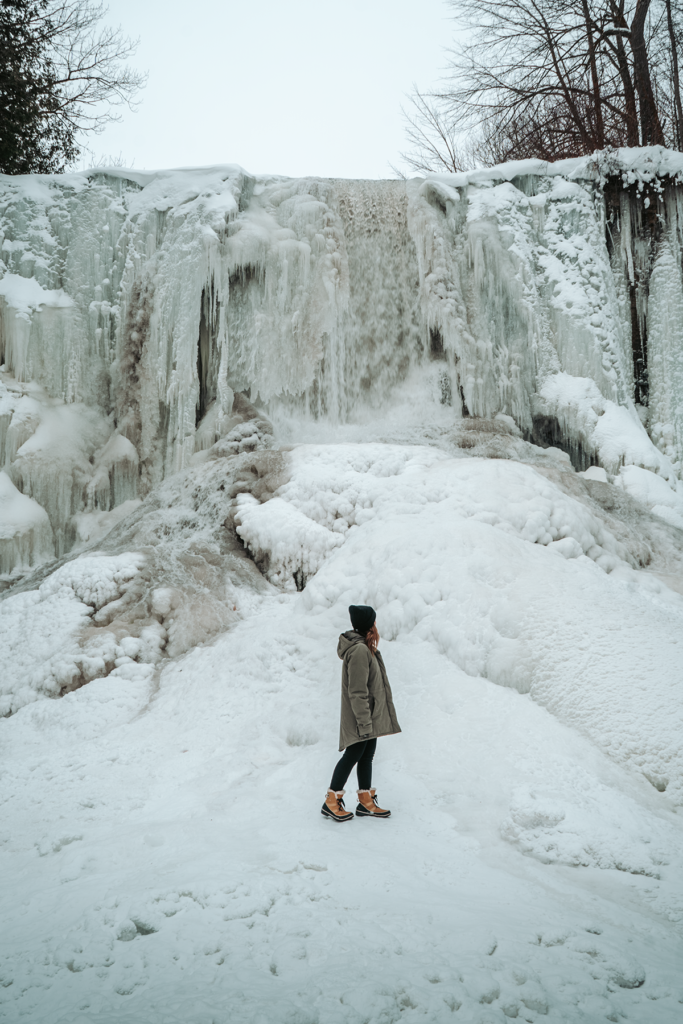
Jones Falls – A hidden gem, Jones Falls is a 12-meter-high waterfall surrounded by rugged cliffs and dense woodland. In winter, it turns into a striking frozen cascade. The trail leading to the falls is 1 km one way and is manageable with proper winter gear.
- Accessibility: Short, easy-to-moderate hike.
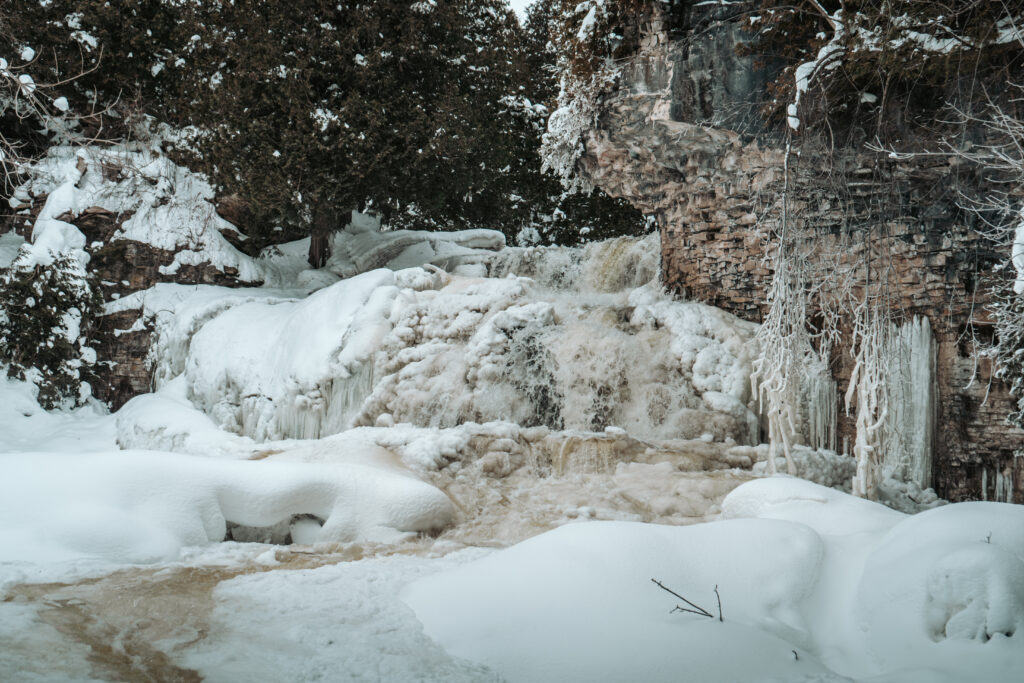
Winter in Bruce Peninsula : Final Thoughts
Visiting Bruce Peninsula in the winter offers a completely different experience compared to the busy summer months. The peaceful landscapes, frozen waterfalls, and snow-covered trails make it a dream destination for outdoor enthusiasts. Whether you’re into snowshoeing, hiking, or photography, this region has something special to offer in the colder months.
If you’re looking for a unique winter getaway in Ontario, Bruce Peninsula in winter should be at the top of your list!
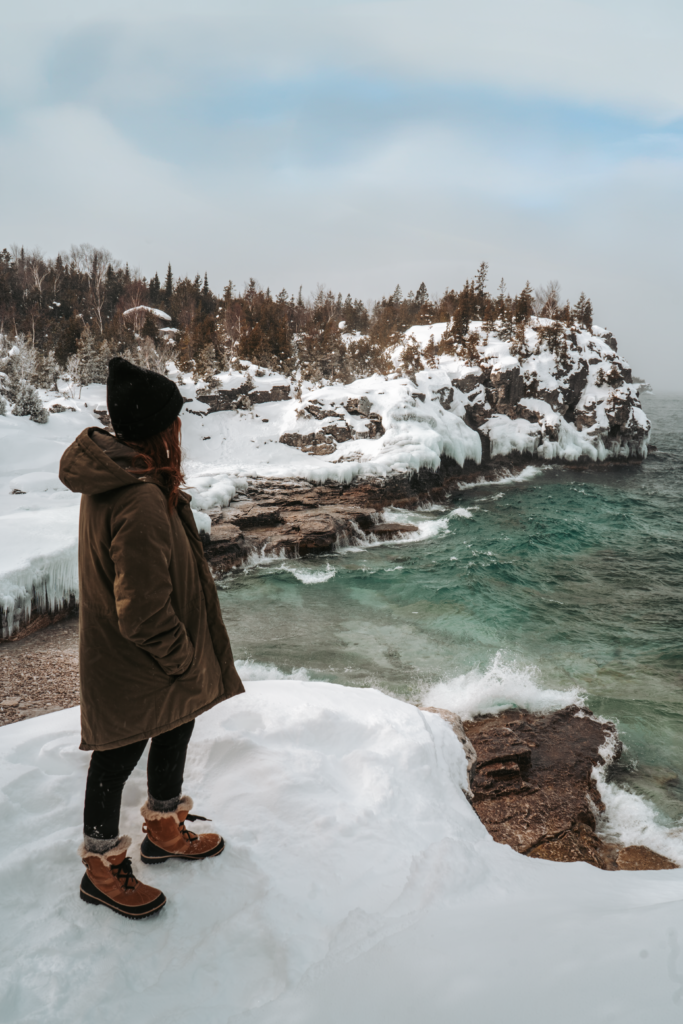
READ MORE OF MY ONTARIO WINTER GUIDES HERE!
PIN THIS FOR LATER
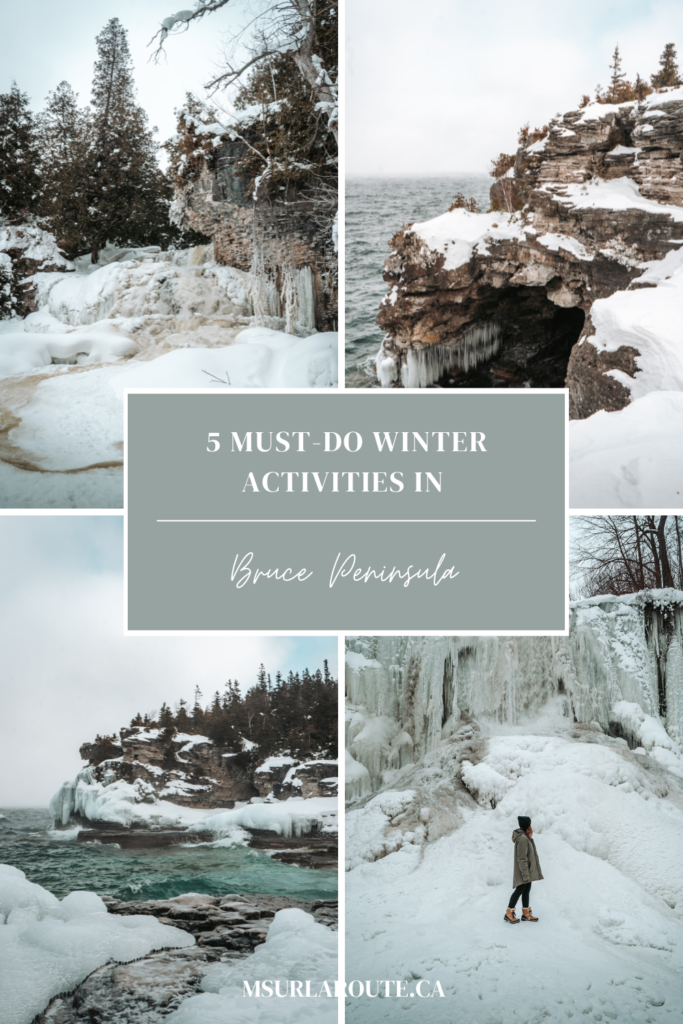
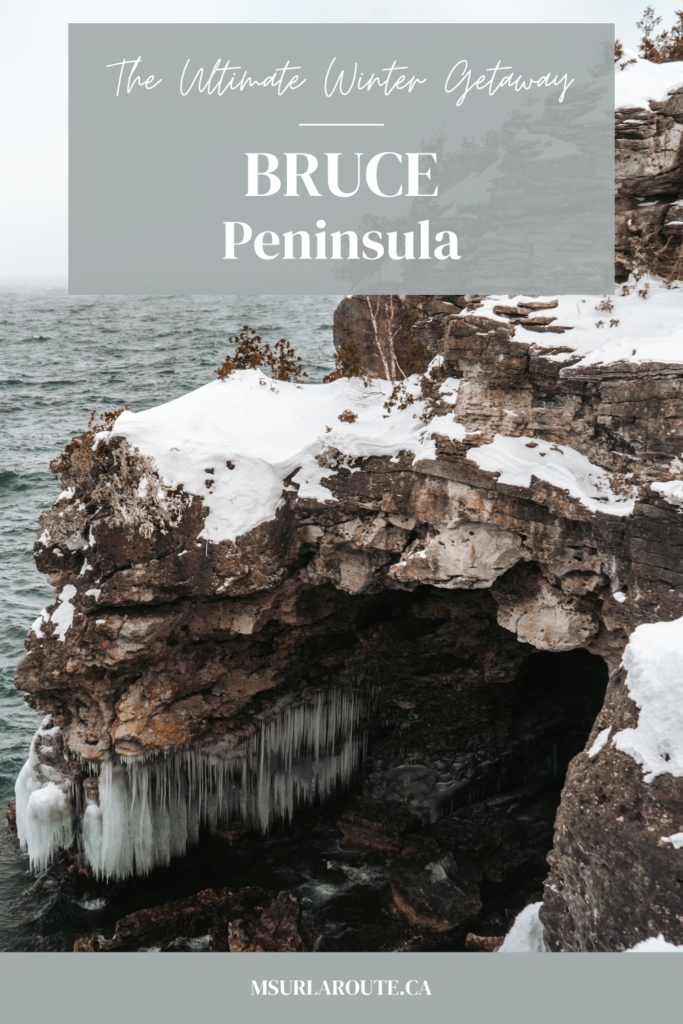
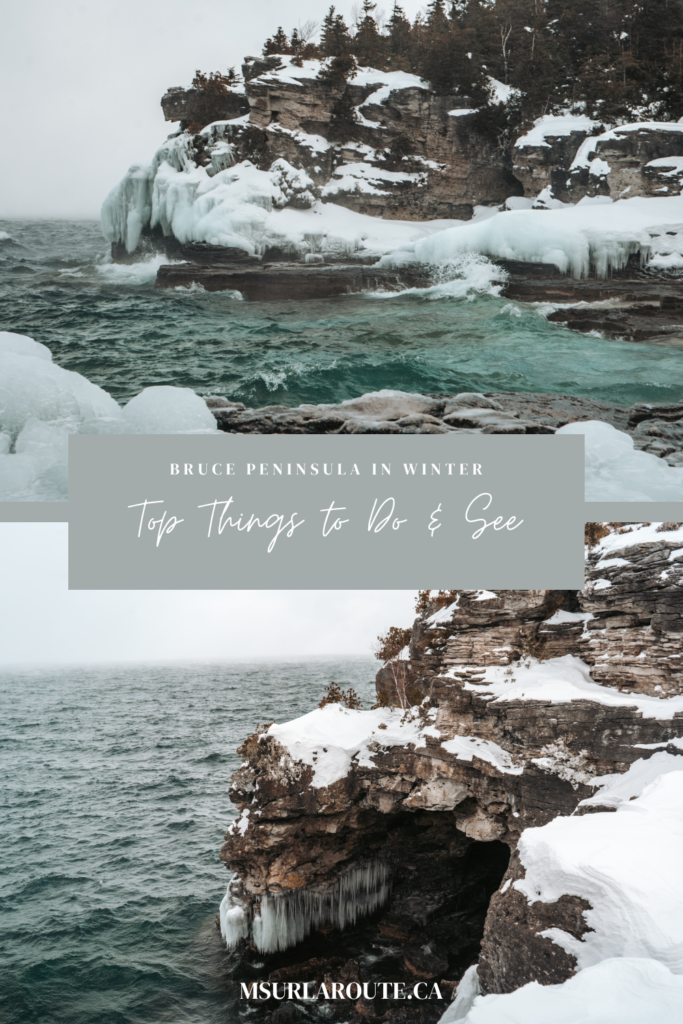
Follow me on Instagram!
Want to touch the southernmost point of mainland Canada? 👇🇨🇦
Then Point Pelee National Park needs to be on your summer list.
From epic sunsets and peaceful marsh boardwalks to migrating birds and butterflies, this park packs a lot into a small space.
In this quick guide:
📍 What to do
🗓️ Best time to visit
⛺ How to camp (hint: it involves oTENTiks)
🦋 And a few cool facts to impress your road trip buddy
Save this for later & tag someone who’d love to stand at the tip of Canada with you 🌊
🇫🇷 La version française de ce texte se trouve dans les commentaires.
#PointPeleeNationalPark #ExploreCanada #TravelOntario #ParksCanada #BucketListTrip #OntarioRoadTrip #NatureEscape #BirdingSeason #WanderOntario

Did you know Peterborough & the Trent-Severn Waterway made the New York Times list of 52 Places to Visit in 2025?
After a weekend exploring the area… I get it. Here’s what makes it one of Ontario’s best summer road trips ⬇️
🌿 Walk with alpacas at a local farm
🚤 Cruise through the world’s highest hydraulic lift lock
🍷 Sip sangria + eat wood-fired pizza at a vineyard
🛶 Visit the brand-new Canadian Canoe Museum
🌄 Hike through caves & forests at Warsaw Caves Conservation Area
🥧 Taste-test butter tarts in Hastings, Campbellford & Lakeside
The perfect Ontario getaway: nature, small towns, good food, and local gems everywhere you turn.
📍 Save this for your next summer road trip!
And tell me below — which stop are you adding to your bucket list?
🇫🇷 Saviez-vous que Peterborough et la voie navigable Trent-Severn figurent sur la liste des 52 destinations à visiter en 2025 selon le New York Times ?
Après un week-end à explorer la région… je comprends tellement pourquoi. Voici pourquoi c’est un road trip incontournable en Ontario cet été ⬇️
🌿 Marcher avec des alpagas dans une ferme locale
🚤 Naviguer sur la plus haute écluse hydraulique au monde
🍷 Boire de la sangria et déguster une pizza au feu de bois dans un vignoble
🛶 Visiter le Musée canadien du canot
🌄 Explorer les sentiers et les grottes du parc Warsaw Caves
🥧 Et bien sûr, faire le plein de tartes au beurre dans les charmants villages de Hastings, Campbellford et Lakeside
Le combo parfait : nature, petites villes, bouffe locale et histoire à chaque détour.
📍 Sauve ce guide pour ton prochain road trip d’été en Ontario !
Et dis-moi en commentaire : quelle activité te tente le plus ?
#discoveron
@ontariotravel and @kawarthas_northumberland
#PeterboroughOntario #TrentSevernWaterway #OntarioRoadTrip #ExploreOntario #SummerInOntario #HiddenGemsOntario #CanadianTravel

These Ontario spots understood the assignment… Saunas in the forest, hot tubs with a view, outdoor soaks under the stars, we’ve got it all!
Here are 6 places where the spa setup is reason enough to book the trip:
1. Aux Box (Huntsville)
2. The Baltic by Fort Tree House Co. (Minden)
3. Back Forty Glamping (Meaford)
4. Anupaya (Deep River)
5. Tiny Stays (Prince Edward County)
6. The June Motel (Beaver Valley)
Tag someone who owes you a spa weekend 💆♀️
🇫🇷 La version française de ce texte se trouve dans les commentaires
#OntarioStays #GlampingOntario #WeekendGetaway #SaunaVibes #HotTubGoals #OntarioSpas #TinyCabins #TravelOntario

I’m on a mission to put Belleville on the map for your Ontario summer adventures 🌞
This is way more than just a drive-by on the 401. Think: charming town vibes, scenic hikes, amazing food (I’m still dreaming about those perogies), and… turtles. 🐢
✨Here’s what I did (don’t forget to save the reel for the full breakdown!):
📍Explored downtown + coffee at Benji’s
🐢 Turtle Pond sanctuary
🥟 Lunch at Kafana (get the perogies!)
🌲 Hiked up Sager Tower (located in Quinte West just a short drive away)
🌮 Dinner at Pop-Ups on the Bay
🍓 Smoothies, wildlife, breweries & more on Day 2
🏖 Bonus: Presqu’ile for a beach day just 35 minutes away.
For this visit, I stayed at the Holiday Inn Express Belleville, perfectly located for all your Bay of Quinte adventures. 👌
Save this for your next summer roadtrip & tag someone who needs a mini escape!
🇫🇷 La version française de ce texte se trouve dans les commentaires
*made in partnership with Bay of Quinte Tourism*
#VisitBelleville #BayofQuinte #OntarioGetaways #HiddenGemsOntario #ExploreOntario #WeekendTripIdeas #MsurlarouteAdventures

Everyone visits Banff, but just an hour away, there’s also this. 👀
Grassi Lake in Kananaskis might just be one of the most underrated hikes in Alberta.
It’s short, it’s scenic, and the turquoise water? Totally unreal.
💦 Take the interpretive trail for waterfalls and forest views
⛰️ End at a lake so vibrant it looks photoshopped
So if you’re heading to the Rockies this summer, don’t sleep on Kananaskis.
Some of the best views are just off the radar.
💬 Been to Kananaskis or still on your list?
💾 Save this if you’re planning an Alberta trip!
🇫🇷 La version française est dans les commentaires! ⬇️
#GrassiLake #KananaskisCountry #AlbertaRoadTrip #HiddenGemsAlberta #ExploreKananaskis #HikingAlberta #BanffVsKananaskis #CanadianRockies #SummerInAlberta

